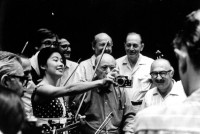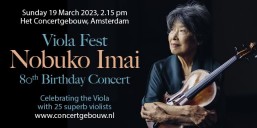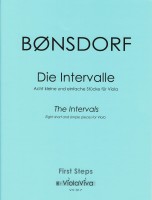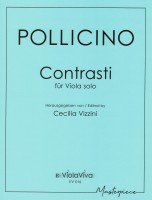
Nobuko Imai turned 80 on March 18 |
The Voice of Viola.
The miracle happened in Tanglewood, near Boston.

with Pablo Casals 1969
Irene Widmer - 21-year-old Nobuko Imai came to the USA on a tour with the Toho Gakuen School Orchestra Strings, led by Seiji Ozawa, who at the time was already well known in the USA as music director of the Ravinia Music Festival in Chicago. Nobuko played the violin in the orchestra.
After the tour, three students stayed a little longer, among them Nobuko, as it was summer and the holidays had started. They went to Tanglewood, to hear a concert of the Boston Symphony, conducted by Pinchas Steinberg. On the program: Strauss' Don Quichote.
At some point, after a cello solo, a beautiful melody ascended from the orchestra, melodious, almost human, but in a higher pitch than the cello. And all of a sudden Nobuko realized: «it is the viola playing… it is really speaking to the audience, mellow and warm like a human voice!»
What she was hearing, there and then, was a new sound – a sound that appealed to her and that she recognized instantaneously as 'the real sound' for her! It was as if her future path revealed itself to her. 'This is the sound I want', she thought.

The viola can have a very big sound, but in Japan, where the viola at the time was only taught as a minor, its sound used to be shaped like a violin, just lower.
Not being able to resist herself, immediately after the concert Nobuko went backstage to see Joseph de Pasquale, who had been playing the viola. She asked him: «Will I be able to play this instrument?» Being a tiny Japanese girl, she was not sure. So he asked her to play for him for a few minutes. «Yes, your hand is quite big», he said, «you will manage.». And from then on it was decided: Nobuko Imai exchanged her violin for a viola that day exactly: Friday 31st July 1964.
Arriving home in Japan, Nobuko started to look for an instrument. After reading an advertisement in the newspaper, she bought a cheap viola and started practicing. Step by step, she designed her own system, as her instinct told her that the way to become a violist was very different from becoming a violinist. There was no teacher available, so she just taught herself. Throughout her journey, she stayed confident, as the beautiful sound of the viola confirmed that she was going in the right direction. Passing her final exams at Toho University, she graduated in viola, not violin, playing Bartók’s Viola Concerto. On the jury, only violinists…

After her final exams, Nobuko moved to the USA to study with David Schwartz at Yale for one year and afterward at Juilliard, where Walter Trampler was her teacher. She passed her entrance exam playing Bach and Bartók on a very poor instrument.
A teacher at Juilliard who was very important to her was Felix Galimir, a great pedagogue at Marlboro and a chamber music instructor at Juilliard. He always leads the student ensembles himself, that way enabling Nobuko and her fellow students to learn from him in the most direct way. At some point, he asked her to come to Marlboro. But again Nobuko chose her own path, and decided to first prepare for the important Viola Competition in Munich. She won the First Prize.
One of her next steps was attending the Casals Festival in Puerto Rico. The small Japanese girl with the big viola attracted attention, and the following year she performed in the orchestra, standing out as a

inspired her to be a violist at
Tanglewood Festival in 1964
young player among the older orchestra members with established careers. And there she started to meet great soloists too. Through all these musicians her name became known, which was the start of her multifaceted career as chamber musician, soloist, recording artist and teacher.
Nobuko is convinced that being unafraid of anything, helped her a great deal. While she sees more chances for young violists in today’s world, she acknowledges that one must tread more carefully now, step by step. Nobuko, however, took giant ones, driven by her passion for her instrument.
Attitude and timing have been key contributors to her career: while she stood out as a viola player in her time, the driving force in her career was her passion to make the voice of the viola speak.
New sheet music |
The Intervals
Eight small and simple pieces for Viola
Series: First Steps
Print & Download
» to the edition
Contrasti
for Viola solo
Series: Masterpiece
Print & Download
» to the edition
Viola Newsletter |
 Do you don't want to miss any news regarding viola anymore? Our monthly viola news letter will keep you informed.
Do you don't want to miss any news regarding viola anymore? Our monthly viola news letter will keep you informed.
» Subscribe to our viola letter for free
|
|
 Visit and like us on Facebook.
Visit and like us on Facebook.
» Music4Viola on Facebook


